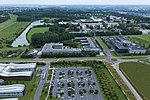Vaularon
Essonne geography stubsFrance river stubsRivers of EssonneRivers of FranceRivers of Île-de-France ... and 1 more
Tributaries of the Seine

The Vaularon is a small river in southern Île-de-France (France), left tributary of the Yvette, in Bures-sur-Yvette, which is a tributary of the Orge and then the Seine. Its source is in Gometz-le-Chatel, in the Essonne department. It is 3.8 km (2.4 mi) long.
Excerpt from the Wikipedia article Vaularon (License: CC BY-SA 3.0, Authors, Images).Vaularon
Résidence de l'Oseraie, Palaiseau
Geographical coordinates (GPS) Address Nearby Places Show on map
Geographical coordinates (GPS)
| Latitude | Longitude |
|---|---|
| N 48.696944444444 ° | E 2.1586111111111 ° |
Address
Résidence de l'Oseraie
Résidence de l'Oseraie
91440 Palaiseau
Ile-de-France, France
Open on Google Maps









